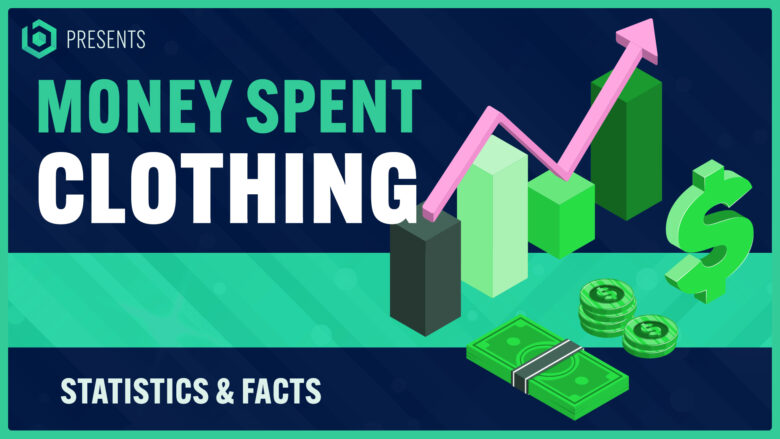Stressed about the amount of money you’re spending on clothing each month? You’re not alone, as the average American person spends around $161 per month on apparel. Our comprehensive analysis delves deep into clothing expenditure statistics, guiding you to better understand your spending patterns and make informed decisions.
Keep reading to find out how these numbers stack up against your own clothing budget!
- The average American person spends around $161 per month on clothing.
- The global clothing market is projected to reach a value of $2.25 trillion by 2025.
- Women tend to spend more on clothing than men, with an average annual expenditure of approximately $2,000 compared to men’s average spending of $1,140.
- Families in different income brackets have varying clothing budgets, ranging from $550 to over $3,500 annually.
Global Spending on Clothing

Global spending on clothing has seen significant growth in recent years, with the U.S. leading as the country that spends the most on clothing compared to other nations.
Overall spending patterns
Spending patterns in the clothing industry vary significantly across different demographics and regions. The following table provides an overview of these patterns, based largely on data from the United States, which, as noted, spends more on clothing than any other country globally.
| Category | Annual Expenditure (Average) |
|---|---|
| Average individual spending | $1,932 |
| Average family spending | $1,700 |
| Women’s clothing expenditure | $2,000 |
| Total apparel industry value | $12 billion |
| Global clothing market projection (2025) | $2.25 trillion |
| Footwear and clothing market projection (2030) | $3.3 trillion |
| Canadian apparel market sales (2019) | $28.04 billion |
| Spending decrease due to COVID-19 | Significant |
These statistics highlight the considerable financial significance of the clothing industry but also underscore the immense impact of COVID-19 on spending patterns.
Adult clothing expenditure
The amount of money spent on adult clothing varies drastically based on various factors such as age, income, and lifestyle choices. Here’s a closer look at the stats.
| Category | Expenditure |
|---|---|
| Average Monthly Spending | $161 |
| Average Annual Spending | $1,700 |
| American Women’s Annual Expenditure | $2,000 |
| Total U.S. Apparel Industry Income | $12 billion |
| Projected Global Clothing Market by 2025 | $2.25 trillion |
| Apparel Sales in Canada (2019) | $28.04 billion |
Evidently, adults contribute significantly to the clothing industry’s global income, with Americans taking the lead in expenditure. This massive spending in the industry reflects the continuous growth and commercial success of the fashion world, despite the temporary setback in 2020 due to the Covid-19 pandemic.
Teenage clothing spending
Teenagers are known to have a higher spending on clothing compared to other age groups. This can be attributed to the influence of peer pressure, fashion trends, and the desire for self-expression.
| Age Group | Average Annual Spending on Clothing |
|---|---|
| 12-14 years | $500-$700 |
| 15-17 years | $800-$1200 |
| 18-19 years | $1300-$2000 |
It’s notable that there are gender differences in spending within this age group. Females in this age category tend to spend more on clothing than their male counterparts.
This trend follows the general pattern in global statistics that indicate that the female gender spends more on clothing than the male gender in all age categories. Brands highly favored by teens include Nike, taking a significant share of teen clothing expenditure due to their strong presence in the sportswear market, which was valued at $265 billion in 2019.
Children’s clothing spending
Children’s clothing spending is an essential part of any family’s budget and falls under the broader umbrella of global apparel expenditure. Families spend considerable amounts on children’s clothing, with this amount varying based on factors such as the age of the child, the season, and the family’s income.
| Age Group | Yearly Spend on Clothing |
|---|---|
| 0 – 2 Years | Approximately $500 |
| 3 – 5 Years | Approximately $350 |
| 6 – 8 Years | Approximately $400 |
| 9 – 12 Years | Approximately $450 |
| 13 – 15 Years | Approximately $500 |
Please note: The above figures are approximations and can vary greatly based on the child’s needs, the family’s lifestyle, and the geographical location.
Statistics for Money Spent on Clothing

Analyzing the financial element of the global clothing industry is truly fascinating. Here are 67 key statistics about money spent on clothing worldwide:
| Statistic | Information |
|---|---|
| 1. Country with highest clothing expenditure | Americans spend more on clothing than any other country in the world. |
| 2. Average monthly clothing expenditure | The average person spends about $161 per month on clothing. |
| 3. Average annual family clothing expenditure | The average American family spends $1,700 on clothes annually. |
| 4. U.S. apparel industry worth | The U.S. apparel industry is a $12 billion business. |
| 5. Global clothing market projection for 2025 | By 2025, the global clothing market is projected to grow to $2.25 trillion. |
| 6. Average annual women’s clothing expenditure | American women spend about $2,000 per year on clothing. |
| 7. Position of clothing industry in e-commerce sales | The clothing industry holds the first position in e-commerce sales globally. |
| 8. Projected market for footwear and clothing in 2030 | The market for footwear and clothing is projected to reach 3.3 trillion USD by the year 2030. |
| 9. Apparel market sales in Canada (2019) | The apparel market in Canada sold clothing worth $28.04 billion in the year 2019. |
| 10. Impact of Covid on clothing industry (2020) | The clothing industry experienced a general decrease in 2020 due to the emergence of the Covid virus. |
This summary gives a snapshot of the financial dynamics of the clothing industry on both a domestic and international level, illustrating the considerable impact this sector has on the global economy.
Gender-based Clothing Expenditure
Men and women have different spending habits when it comes to clothing.
Money spent on men’s clothing
According to recent statistics, the yearly expenditure of men on clothing averages at $323. This highlights an intriguing pattern in the consumer market despite the traditionally prevalent belief that women are the major contributors to the fashion industry. The break down of these spending habits becomes more clear when viewed in detail.
| Category | Average Annual Spending | Percentage of Total Clothing Expenditure |
|---|---|---|
| Tops | $110 | 34% |
| Bottoms | $75 | 23% |
| Underwear | $60 | 19% |
| Outerwear | $50 | 15% |
| Accessories | $28 | 9% |
Despite men buying fewer clothes, a considerable part of their expenditure is allocated to tops, accumulating to 34% of total clothing expenditure. Following that, men tend to spend on bottoms and underwear, making up 23% and 19% of their total clothing expense respectively. Outerwear and accessories hold less priority, accounting for 15% and 9% of total clothing expenditure respectively. These statistics show that men’s shopping habits primarily focus on essential items, with less emphasis on auxiliary products.
Money spent on women’s clothing
Women are known to have a significant influence on the clothing industry. They contribute the most to the overall amount spent on clothing, with an average annual spending of approximately $2,000. This shows a striking comparison to men’s clothing expenditure as women spend 76% more on clothes than men. The data below gives a further breakdown of women’s expenditure on clothing.
| Age Group | Average Annual Spending |
|---|---|
| Women (Overall) | $2,000 |
| Men (Overall) | $1,140 (24% less than women) |
| Women aged 45-54 | $793 |
It is also important to mention that women are not just the major spenders but are also major decision-makers when it comes to consumer purchasing. Their decisions influence 70 to 80% of all consumer purchasing. This shows the significant impact women have on the clothing market.
Family Clothing Budget

The average American family spends around $1,700 on clothes annually.
Average family spending
The average family spending on clothing varies significantly based on income, the number of family members, and their spending habits. Economically, the budget allocated to clothing purchases annually can range. Below is a breakdown of the average annual spending on clothing for families in different income brackets.
| Income Level | Average Annual Clothing Budget |
|---|---|
| Low Income (<$20,000) | $550 – $750 |
| Middle Income ($20,000 – $70,000) | $1,700 |
| High Income (>$70,000) | $2,000 – $3,500 |
Remember, these are averages and actual spending can be higher or lower depending on individual circumstances. Higher-income families, for example, are known to spend more on clothing, with some reaching up to $3,500 per year. On the other hand, the average American family spends about $1,700 on clothing yearly. Those in the lower income brackets are often found to spend between $550 and $750 annually on clothing. However, the amount spent on clothing does not always equate to quantity as high-income earners might be buying fewer but more expensive pieces.
Proportion of income spent on clothing
The proportion of income that households spend on clothing can vary significantly depending on various factors such as income level, number of family members, and budget priorities. Here are some statistics that provide more insight into this subject.
| Income Level | Average Proportion of Income Spent on Clothing |
|---|---|
| Lower Income | Higher proportion of income |
| Higher Income | Lower proportion of income |
| Average Household | 3.8% of income |
It is important to note that the data represents averages and individual spending habits can significantly deviate from this. For example, fashion-forward individuals or families with school-age children may spend a higher percentage of their income on clothing. Meanwhile, those who prioritize savings or other forms of expenditure might spend less. However, on average, a typical American family spends around $1,800 per year on clothing, which is approximately 3.8% of their income.
Online Clothing Shopping Statistics
Online clothing shopping is on the rise, with a significant percentage of US shoppers opting to buy their apparel online.
Percentage of US shoppers buying clothing online
With the advent of the digital age, more and more Americans are shifting towards online shopping for clothing. Here are some insightful statistics elucidating the percentage of US shoppers buying clothing online.
| Demographics | Percentage of Shoppers Buying Clothing Online |
|---|---|
| All US Shoppers | 75% |
| Millennials | Higher than average, making twice as many fashion purchases online than boomers |
| Men | Lower than women, but they shop more frequently online |
While the majority of Americans are adapting to e-commerce for their fashion needs, there is still a significant 25% of US shoppers who do not buy clothing online. Despite this, the trend clearly portrays a widespread shift toward online shopping, with Millennials leading the charge. They make twice as many fashion purchases online as compared to the boomers. On the other hand, men, while they shop more frequently online, they buy fewer clothes in comparison to women. This lead to an understanding that the gender and generation of the shoppers significantly influence their online shopping behavior.
Millennials vs boomers online fashion purchases
Millennials and boomers have distinct shopping habits when it comes to online fashion purchases. Millennials, who are known for their tech-savviness, lead the way in embracing online shopping for clothing. In fact, they make twice as many fashion purchases online compared to boomers.
This can be attributed to their comfort with technology and the convenience of browsing through various options from the comfort of their own homes. On the other hand, boomers may still prefer traditional brick-and-mortar stores when it comes to purchasing clothing items. Understanding these differences is essential for retailers looking to cater to different generations and maximize their sales in the ever-evolving digital landscape.
Unworn Clothing Statistics
According to recent studies, a significant proportion of wardrobes remain filled with unworn clothing.
Proportion of wardrobe never worn
More than half of women admit that a quarter of their wardrobe goes untouched, with these unworn items taking up valuable space. This staggering statistic highlights the prevalent issue of unused clothing in our closets. Whether it’s clothes bought on impulse or pieces that no longer fit, many wardrobes contain a significant portion of garments that never see the light of day. This not only hinders efficient storage but also represents wasted money and resources. It’s crucial to evaluate our shopping habits and make conscious choices to maximize the use and value of our clothing.
Shoe Purchase Statistics
On average, people spend $750 annually on shoes. Interested in learning more fascinating statistics about money spent on clothing? Keep reading!
Average yearly spending on shoes
The average person spends approximately $388 per year on shoes. This includes both men and women, but interestingly, women tend to spend more on footwear than men. On average, women spend around $571 per year on clothing, with the age group of 45-54 being the highest spenders. In comparison, men typically spend about $323 annually on clothing. When it comes to shoes specifically, 32% of women own more than 25 pairs, while the average person buys about 7.8 pairs of shoes each year. So whether it’s keeping up with fashion trends or simply enjoying a new pair of kicks, investing in footwear is an important part of our annual budget.
Average number of shoes bought per year
On average, people purchase approximately 8 pairs of shoes per year. This means that the average household spends around $388 annually on footwear alone. With 32% of women owning more than 25 pairs of shoes, it’s clear that shoes are a significant part of our wardrobe and personal style. Whether it’s keeping up with fashion trends or simply finding the right pair for every occasion, our shoe-buying habits contribute to the thriving global apparel industry, which is worth an impressive $2.4 trillion. So if you find yourself eyeing a new pair of kicks, know that you’re not alone in your love for fashionable footwear.
Clothing Spending by Age Group
The spending trends for different age groups vary significantly when it comes to clothing. Find out which age group spends the most and why. Read more to discover fascinating insights into clothing expenditure across generations.
Spending trends for different age groups
Different age groups have distinct spending trends when it comes to clothing. On average, women aged 45-54 tend to spend the most on clothing, with an average expenditure of about $793 per year. This group prioritizes fashion and invests in quality wardrobe pieces. Younger adults, particularly those in their late teens and early twenties, are more likely to follow current trends and have a higher frequency of shopping trips.
They often allocate a significant portion of their budget towards clothing purchases as they navigate personal style choices and explore different fashion trends. Older individuals, on the other hand, typically prioritize comfort and practicality over fashion-forward choices, resulting in less frequent shopping trips and lower overall spending on clothing. These spending patterns highlight how age influences consumer behavior when it comes to purchasing garments for personal use.
[Word Count: 178]
Impact of the COVID-19 Pandemic on Clothing Expenditure
The COVID-19 pandemic has significantly impacted clothing expenditure, with a decrease in spending on clothing and footwear observed across the United States.
Decrease in clothing and footwear spending
The COVID-19 pandemic has had a significant impact on the clothing and footwear industry, leading to a decrease in spending in these sectors. In Australia, for example, the clothing market experienced an 8.5 percent decrease in 2020 due to the emergence of the virus. The luxury sector also took a hit, with a 25 percent drop in sales during the first quarter of the year. Fast fashion brands like Zara and H&M Group were projected to suffer a 12.3 percent decline in sales as well.
This trend was not limited to Australia alone; Spain saw a staggering 70 percent decrease in clothing and footwear spending during this time. As people focused more on essentials like food and healthcare, non-essential purchases like clothes took a backseat. However, as the situation gradually improves and economies recover from the pandemic’s effects, it is expected that spending patterns will slowly return to normal levels.
Changes in American spending habits
The COVID-19 pandemic has had a profound impact on American spending habits, with many people reassessing their priorities and cutting back on nonessential expenses. According to recent surveys, about 63% of Americans have reduced their overall spending during the pandemic. With a focus on essential items like food and healthcare, there has been a significant decrease in spending on nonessential items such as clothing. This shift in consumer behavior has affected various industries, including the apparel business which experienced a 25 percent drop in the first quarter of 2020. As people prioritize financial security and adapt to new circumstances, retailers need to optimize their online platforms and make it easy for shoppers to add items to their carts and check out quickly.
Role of Mobile Devices in Clothing Shopping
Mobile devices play a significant role in clothing shopping, with a growing number of consumers using their smartphones for window shopping and making impulse purchases.
Amazon’s apparel sales
Amazon is a dominant player when it comes to selling clothes online, surpassing all other e-commerce websites. In fact, a staggering 76% of customers shop for apparel on Amazon, with the majority making their purchases through their mobile devices. The convenience of shopping from your smartphone allows for easy browsing and comparison of prices, leading to increased chances of impulse buys. And it’s not just window shopping; 67% of shoppers use their smartphones to browse clothing items before eventually making a purchase. It’s clear that optimizing the mobile experience and streamlining checkout processes can greatly benefit retailers in this highly competitive market. With Amazon leading the way in apparel sales, it’s important for other retailers to adapt and make shopping as seamless as possible for customers on mobile platforms.
Fact:
1. Amazon sells more apparel than any other website, with 76% of customers shopping from their mobile devices.
2. 67% of shoppers use their smartphones to window shop, and 77% of these online window shoppers make impulse buys.
3. Shopping from a smartphone is more convenient and allows for easier browsing and price comparison, which may lead to more impulse buys.
4. Retailers should structure their mobile sites to make it easy for shoppers to add items to their carts and check out quickly.
Use of smartphones for window shopping and impulse buys
Mobile devices, particularly smartphones, have revolutionized the way people shop for clothing. Nowadays, 67% of shoppers use their smartphones for window shopping, making it a vital part of the clothing shopping experience. It’s not just about browsing anymore; 77% of online window shoppers actually make impulse buys when using their mobile devices. Amazon, the largest online retailer, takes advantage of this trend by selling more apparel than any other website. In fact, 76% of Amazon customers use their smartphones to shop.
The convenience and ease-of-use that smartphones offer in terms of browsing and comparing prices contribute to this growing reliance on mobile devices for clothing purchases. Retailers should recognize this shift and optimize their mobile sites to provide seamless item addition and quick checkouts. It’s clear that smartphones play a crucial role in driving sales through both window shopping and impulse purchases in the world of fashion retailing.
Our Takeaway
In conclusion, the statistics surrounding money spent on clothing are both fascinating and eye-opening. From global spending patterns to gender-based expenditure, it is clear that clothing holds a significant place in our lives and budgets.
The impact of the COVID-19 pandemic has also affected consumer behavior, with online shopping becoming increasingly popular. As we navigate through these changes, understanding our spending habits can help us make informed choices and prioritize financial well-being.
Article Sources & Helpful Links
Here are some helpful links that may help you learn more:
- Global Apparel Market Statistics: Comprehensive data and facts about the apparel market worldwide.
- Nike Official Website: The official website of Nike, a leading brand in the apparel industry.
- Nike Help Page: The help and FAQ page of Nike for customer support and inquiries.
- Adidas Help Page: The help and customer service page of Adidas, another major player in the apparel industry.
- Consumer Expenditure Surveys: The Consumer Expenditure Surveys (CE) program provides data on expenditures, income, and demographic characteristics of consumers in the United States.
- Current Population Survey: The Current Population Survey (CPS) is a monthly survey sponsored by the Bureau of Labor Statistics and conducted by the U.S. Census Bureau.
Money Spent on Clothing Statistics (FAQs)
What is the average amount of money spent on clothing each year?
According to the data, the average American shopper spends approximately $1,800 on clothing each year.
How much do women spend on clothing on average?
Women spend an average of $2,000 on clothing and shoes every year.
Are there any statistics to learn about the expenditure on clothing?
Yes, there are various statistics available to learn about the consumption of clothing. Organizations like the Bureau of Labor Statistics collect data on consumer expenditure and provide facts and figures related to the clothing market.
Are there ways to save money on clothing?
Yes, there are several ways to save money on clothing. Some options include shopping during sales, using coupons or discounts, buying secondhand or thrifted items, and making conscious buying decisions.
Do people spend more money on clothes as they get older?
The data suggests that consumer spending on clothing tends to decrease as people get older. The age group of 35-44 years generally spends the most on clothing.
How much money is spent globally on apparel?
The global apparel industry makes a significant contribution to the economy, with consumer expenditure on clothing reaching approximately $4 billion annually.
What is the role of fashion companies in the clothing sector?
Fashion companies play a vital role in the clothing sector. They design and produce new clothes according to the latest fashion trends, cater to consumer demands, and contribute to the overall growth of the industry.
How much do people spend on footwear?
On average, individuals spend around $200 on footwear each year.
How has the clothing expenditure been affected by the COVID-19 pandemic?
The COVID-19 pandemic has impacted the clothing industry significantly. With lifestyle changes and economic uncertainty, there has been a decrease in the clothing expenditure compared to previous years.
Which retailers dominate the clothing market?
The clothing market is highly competitive, with various retailers serving different segments of the population. Some popular retailers include Inditex (owner of Zara), H&M, and Gap Inc.




